Abstract
BACKGROUND. Although the inverse association between socioeconomic status (SES) and blood pressure has often been observed, little is known about the relationship between SES and dietary risk factors for elevated blood pressure. Therefore, this study described the distribution of dietary intakes of sodium, potassium, and calcium and examined the association between electrolyte intake and SES among 1784 Black men and women aged 25 to 50 residing in eastern North Carolina. METHODS. Household interviews were conducted in 1988 to obtain information on psychosocial and dietary correlates of blood pressure. Electrolyte intake (mg/day) was assessed using a food frequency questionnaire adapted to reflect regional and ethnic food preferences. SES was categorized into three levels defined by the participant's educational level and occupation. RESULTS. After adjustment for age and energy intake, potassium and calcium intake increased with increasing SES for both sexes. Sodium intake was high for all groups and did not vary markedly with SES, but sodium to potassium and sodium to calcium ratios decreased with increasing SES. In addition, high SES individuals were more likely to believe that diet affects risk for disease and to report less salt use at the table and less current sodium consumption than in the past. CONCLUSION. These data indicate that nutritional beliefs as well as the consumption of electrolytes are associated with SES in Black adults.
Full text
PDF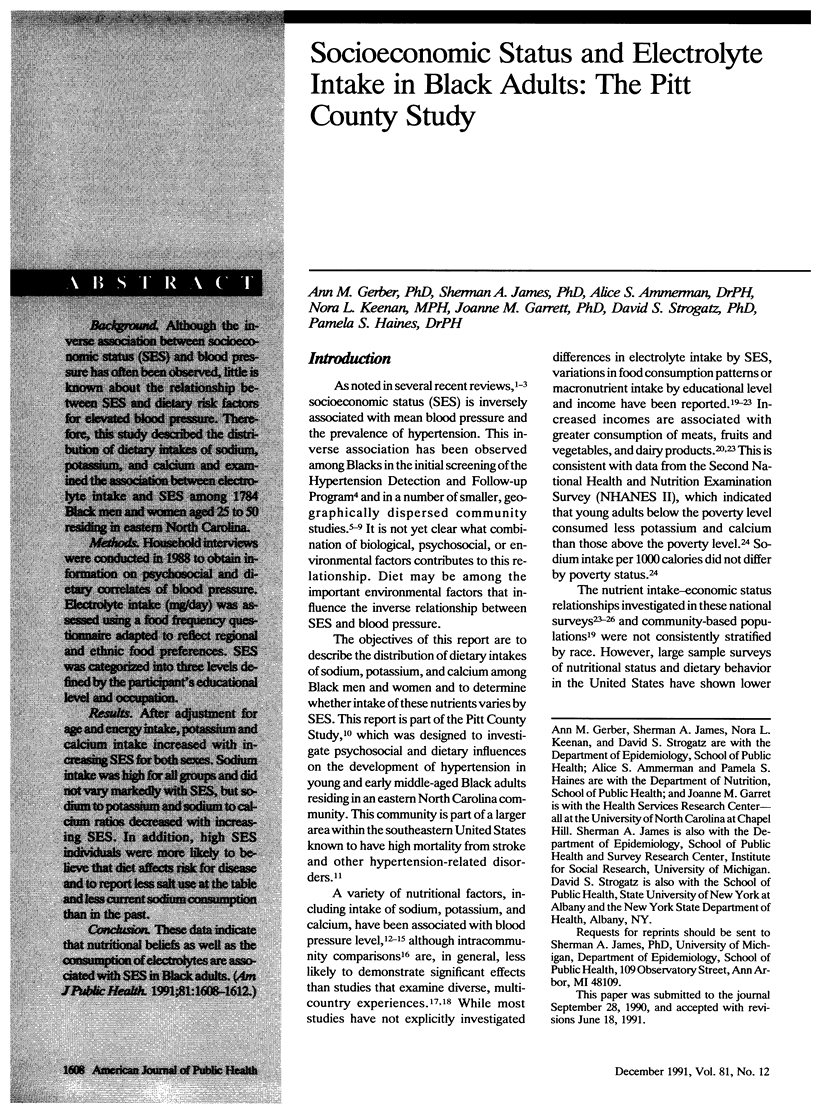
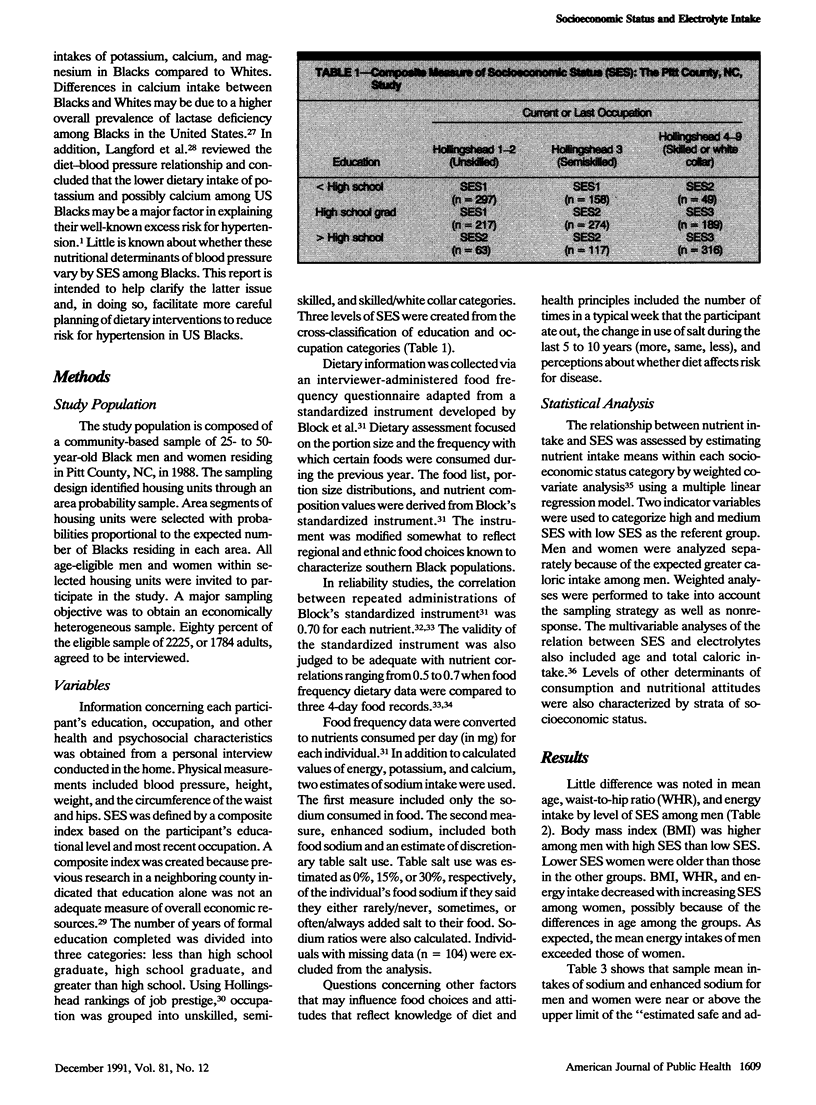
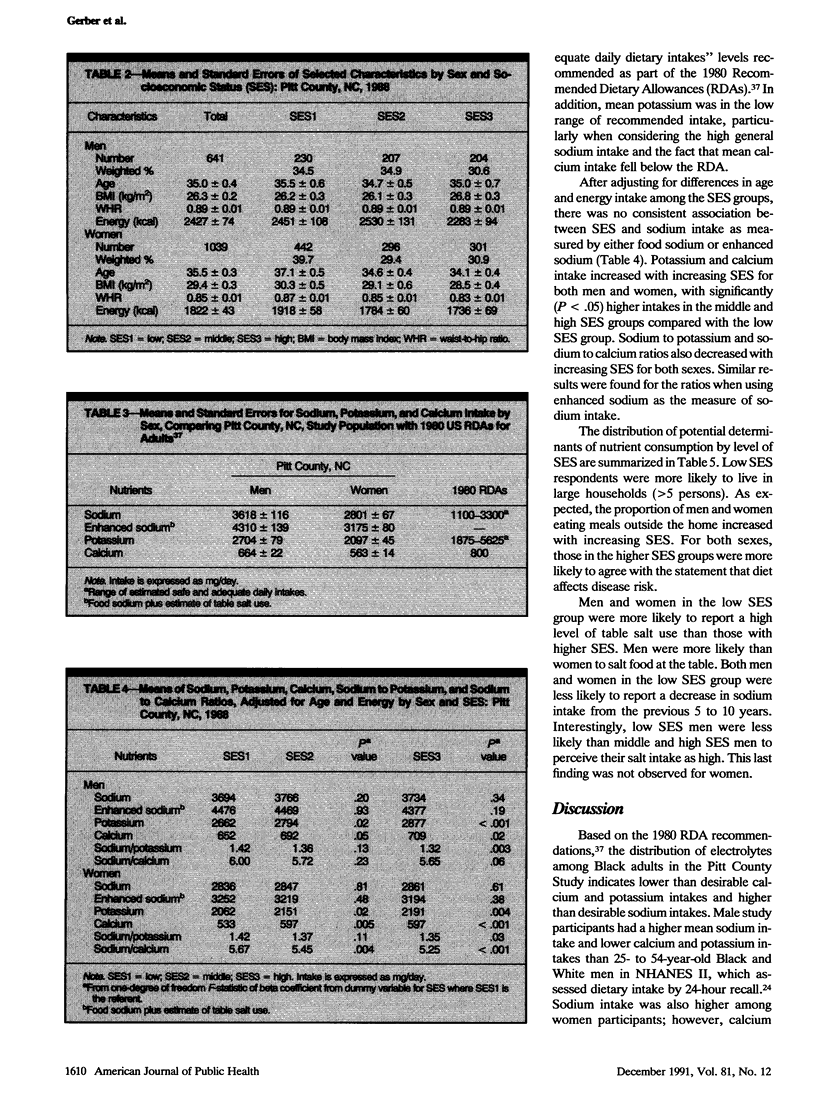
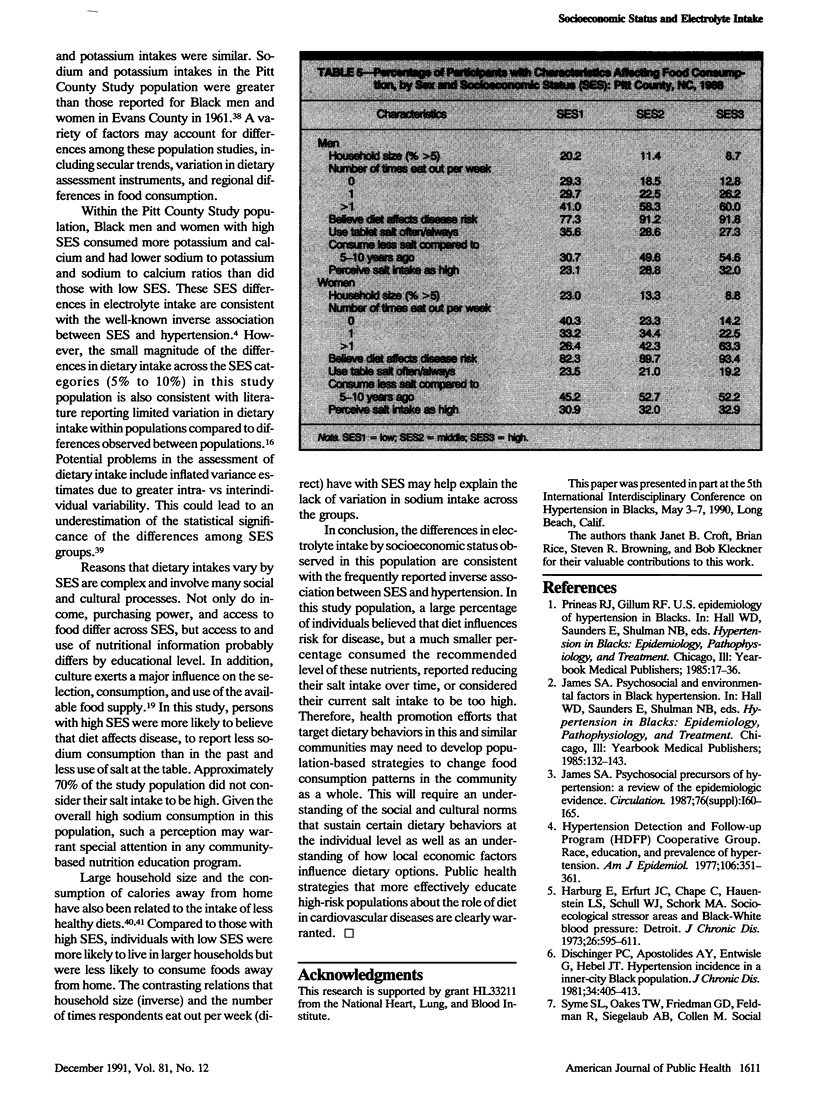
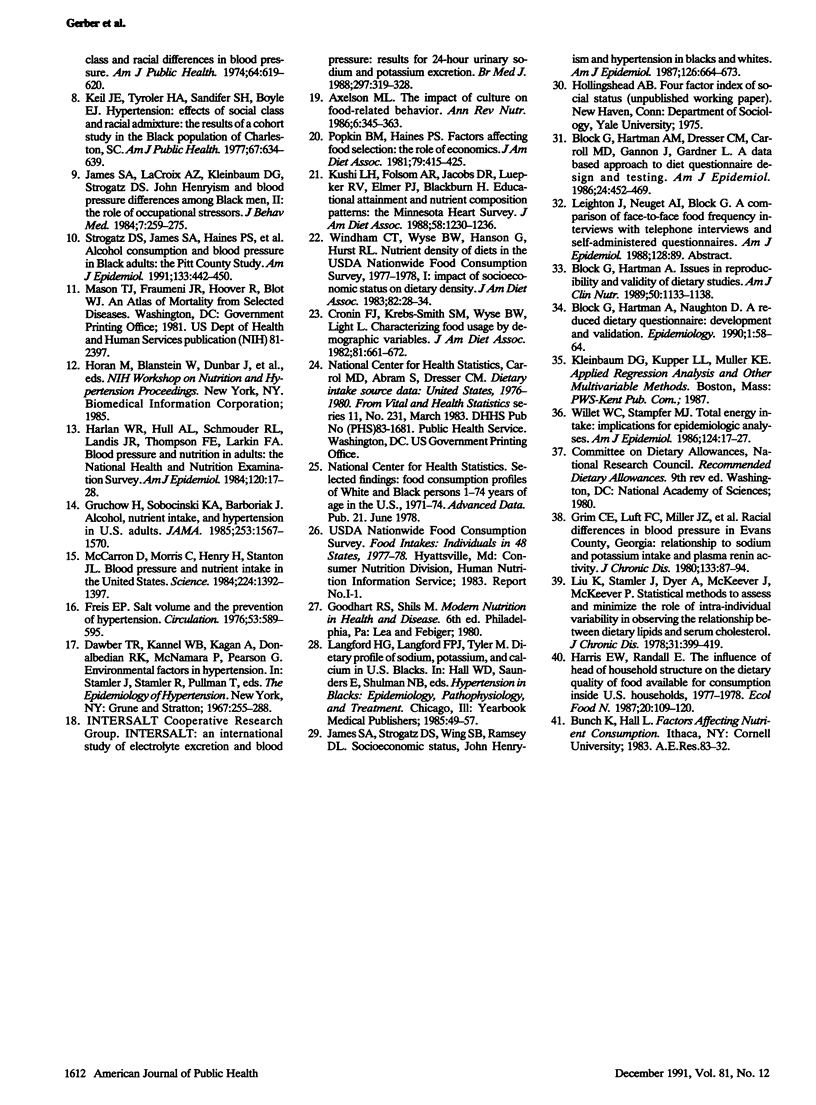
Selected References
These references are in PubMed. This may not be the complete list of references from this article.
- Axelson M. L. The impact of culture on food-related behavior. Annu Rev Nutr. 1986;6:345–363. doi: 10.1146/annurev.nu.06.070186.002021. [DOI] [PubMed] [Google Scholar]
- Block G., Hartman A. M., Dresser C. M., Carroll M. D., Gannon J., Gardner L. A data-based approach to diet questionnaire design and testing. Am J Epidemiol. 1986 Sep;124(3):453–469. doi: 10.1093/oxfordjournals.aje.a114416. [DOI] [PubMed] [Google Scholar]
- Block G., Hartman A. M. Issues in reproducibility and validity of dietary studies. Am J Clin Nutr. 1989 Nov;50(5 Suppl):1133–1235. doi: 10.1093/ajcn/50.5.1133. [DOI] [PubMed] [Google Scholar]
- Block G., Hartman A. M., Naughton D. A reduced dietary questionnaire: development and validation. Epidemiology. 1990 Jan;1(1):58–64. doi: 10.1097/00001648-199001000-00013. [DOI] [PubMed] [Google Scholar]
- Cronin F. J., Krebs-Smith S. M., Wyse B. W., Light L. Characterizing food usage by demographic variables. J Am Diet Assoc. 1982 Dec;81(6):661–673. [PubMed] [Google Scholar]
- Dischinger P. C., Apostolides A. Y., Entwisle G., Hebel J. R. Hypertension incidence in an inner-city black population. J Chronic Dis. 1981;34(8):405–413. doi: 10.1016/0021-9681(81)90039-4. [DOI] [PubMed] [Google Scholar]
- Freis E. D. Salt, volume and the prevention of hypertension. Circulation. 1976 Apr;53(4):589–595. doi: 10.1161/01.cir.53.4.589. [DOI] [PubMed] [Google Scholar]
- Grim C. E., Luft F. C., Miller J. Z., Meneely G. R., Battarbee H. D., Hames C. G., Dahl L. K. Racial differences in blood pressure in Evans County, Georgia: relationship to sodium and potassium intake and plasma renin activity. J Chronic Dis. 1980;33(2):87–94. doi: 10.1016/0021-9681(80)90032-6. [DOI] [PubMed] [Google Scholar]
- Gruchow H. W., Sobocinski K. A., Barboriak J. J. Alcohol, nutrient intake, and hypertension in US adults. JAMA. 1985 Mar 15;253(11):1567–1570. [PubMed] [Google Scholar]
- Harburg E., Erfurt J. C., Chape C., Hauenstein L. S., Schull W. J., Schork M. A. Socioecological stressor areas and black-white blood pressure: Detroit. J Chronic Dis. 1973 Sep;26(9):595–611. doi: 10.1016/0021-9681(73)90064-7. [DOI] [PubMed] [Google Scholar]
- Harlan W. R., Hull A. L., Schmouder R. L., Landis J. R., Thompson F. E., Larkin F. A. Blood pressure and nutrition in adults. The National Health and Nutrition Examination Survey. Am J Epidemiol. 1984 Jul;120(1):17–28. doi: 10.1093/oxfordjournals.aje.a113870. [DOI] [PubMed] [Google Scholar]
- James S. A., LaCroix A. Z., Kleinbaum D. G., Strogatz D. S. John Henryism and blood pressure differences among black men. II. The role of occupational stressors. J Behav Med. 1984 Sep;7(3):259–275. doi: 10.1007/BF00845359. [DOI] [PubMed] [Google Scholar]
- James S. A. Psychosocial precursors of hypertension: a review of the epidemiologic evidence. Circulation. 1987 Jul;76(1 Pt 2):I60–I66. [PubMed] [Google Scholar]
- James S. A., Strogatz D. S., Wing S. B., Ramsey D. L. Socioeconomic status, John Henryism, and hypertension in blacks and whites. Am J Epidemiol. 1987 Oct;126(4):664–673. doi: 10.1093/oxfordjournals.aje.a114706. [DOI] [PubMed] [Google Scholar]
- Keil J. E., Tyroler H. A., Sandifer S. H., Boyle E., Jr Hypertension: effects of social class and racial admixture: the results of a cohort study in the black population of Charleston, South Carolina. Am J Public Health. 1977 Jul;67(7):634–639. doi: 10.2105/ajph.67.7.634. [DOI] [PMC free article] [PubMed] [Google Scholar]
- Kushi L. H., Folsom A. R., Jacobs D. R., Jr, Luepker R. V., Elmer P. J., Blackburn H. Educational attainment and nutrient consumption patterns: the Minnesota Heart Survey. J Am Diet Assoc. 1988 Oct;88(10):1230–1236. [PubMed] [Google Scholar]
- Liu K., Stamler J., Dyer A., McKeever J., McKeever P. Statistical methods to assess and minimize the role of intra-individual variability in obscuring the relationship between dietary lipids and serum cholesterol. J Chronic Dis. 1978;31(6-7):399–418. doi: 10.1016/0021-9681(78)90004-8. [DOI] [PubMed] [Google Scholar]
- McCarron D. A., Morris C. D., Henry H. J., Stanton J. L. Blood pressure and nutrient intake in the United States. Science. 1984 Jun 29;224(4656):1392–1398. doi: 10.1126/science.6729459. [DOI] [PubMed] [Google Scholar]
- Popkin B. M., Haines P. S. Factors affecting food selection: the role of economics. J Am Diet Assoc. 1981 Oct;79(4):419–425. [PubMed] [Google Scholar]
- Strogatz D. S., James S. A., Haines P. S., Elmer P. J., Gerber A. M., Browning S. R., Ammerman A. S., Keenan N. L. Alcohol consumption and blood pressure in black adults: the Pitt County Study. Am J Epidemiol. 1991 Mar 1;133(5):442–450. doi: 10.1093/oxfordjournals.aje.a115911. [DOI] [PubMed] [Google Scholar]
- Willett W., Stampfer M. J. Total energy intake: implications for epidemiologic analyses. Am J Epidemiol. 1986 Jul;124(1):17–27. doi: 10.1093/oxfordjournals.aje.a114366. [DOI] [PubMed] [Google Scholar]
- Windham C. T., Wyse B. W., Hansen R. G., Hurst R. L. Nutrient density of diets in the USDA Nationwide Food Consumption Survey, 1977-1978: I. Impact of socioeconomic status on dietary density. J Am Diet Assoc. 1983 Jan;82(1):28–34. [PubMed] [Google Scholar]


